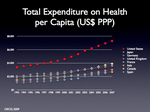 Courtesy of Alex Tabarrok, I had my attention drawn to a great series of blog posts by Austin Frank and Aaron Carroll, over at The Incidental Economist, on the subject of, “What Makes The US Health Care System So Expensive?”
Courtesy of Alex Tabarrok, I had my attention drawn to a great series of blog posts by Austin Frank and Aaron Carroll, over at The Incidental Economist, on the subject of, “What Makes The US Health Care System So Expensive?”
As Carroll noted in his initial post on the topic, part of the explanation for why our health care system is so expensive is that health care spending rises with a country’s wealth (a point I’ve previously blogged about here). Once people have the wealth to take care of the basics like food and clothing and shelter, they start spending more on maintaining their health and extending their lives. So part of the explanation of why we spend so much more on health care (compared to, say, a country like Bangladesh) is that we have so much greater wealth.
But that’s the obvious and, as Carroll points out, uninteresting part of the explanation. The really interesting part is that if you graph a country’s health care spending with its wealth, there is almost a perfect line of correlation, a direct proportion between a given increase in wealth and a given increase in health care expenditures.
The US, however, is a huge outlier. It sits far above this line of correlation, spending much more on health care than you would predict given our level of wealth. We spend about two to three hundred percent more on our health care than other wealthy countries like Germany and Japan.
In seeking to explain why we spend so much on health care, Carroll examines a series of red herrings – conventional scapegoats for the high cost of health care that really have nothing to do with why health care is so expensive. One red herring examined by Carroll is medical malpractice lawsuits. Drawing on the same Health Affairs data that I have previously blogged about, Carroll puts the entire cost of medical malpractice lawsuits (including the cost of so-called “defensive medicine” at about 2.4% of total health care spending.
Only about one-fifth of that 2.4% figure is attributable to actual payouts and defense lawyer costs in medical malpractice cases; the rest is spending that, as Carroll points out, may have a benefit to the patient. The extra test or procedure will sometimes detect a disease or problem before it manifests itself, lowering the treatment cost.
As Carroll, the economist, concludes, “[Medical] malpractice is not the root cause of our cost problem, and tort reform isn’t the solution. I wish it were that easy.”
It’s time we focus on the real problems in health care, including the “fee-for-service” model that the Health Affairs article cited by Carroll says dwarfs the spending on medical malpractice lawsuits and the hard-to-calculate defensive medicine costs. Villainizing medical malpractice lawyers and the victims of medical malpractice is not going to bring our health care costs down and it certainly won’t take care of the victims of medical malpractice.
I encourage you to read Carroll’s blog series on your own, as it is too difficult to encapsulate all of the insights into a single blog post.
This blog is maintained by the Boston medical malpractice lawyers at The Law Office of Alan H. Crede, P.C. The blog neither contains nor offers legal advice.
